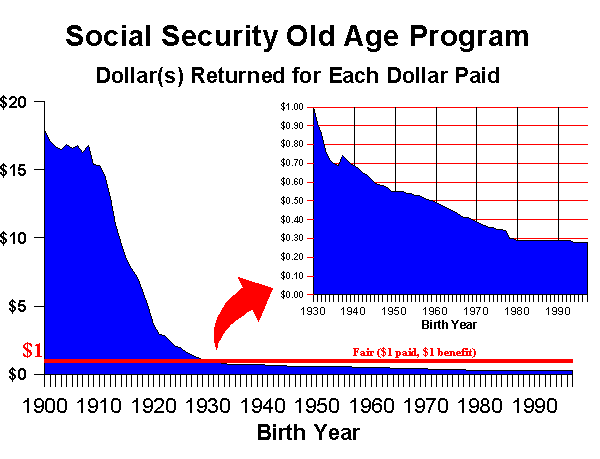
Are You A Donor?
© William Larsen
Politicians refer to states which send $1 in taxes to Washington and get back less than $1 in federal funding levels as donor states. We could apply this same term to tax payers. Let us think outside the box. How much do you pay in Social Security taxes? What will you get back?
Let us be more specific, compare birth years instead of states. Should each birth year on average get back $1 for each dollar of combined tax and interest in the form of Social Security? Who are donors and who are receivers?
Social Security has defined the average worker as one who makes the average wage. They have also provided what that average wage has been in each year since 1951. Social Security has also published the average Social Security benefit for each year. Using a bit of math, I calculated the average wage for years 1937 through 1951.
Using the Social Security's Old Age Survivor's Insurance formula, I calculated what future Social Security benefits would be based on earning the average US wage. In addition, I used the US treasury rate for each year since 1937 to present to determine what a theoretical person would have earned on their Employee and Employer contributions. Using the reported Social Security COLA's for each year since 1937, Social Security benefits were adjusted each year.
Using an iterative routine, I solved for what would have been the correct benefit based on US Treasury, Employee and Employer contributions and compared them to what was actually paid or will be paid. This comparison gives us insight into how much each birth year paid in and was paid in terms of Social Security benefits.
A worker who paid $1 into Social Security with credited interest at the US Treasury rate should be paid $1 in Social Security benefits. This person was paid $1 for each $1 they paid. This would be fair.
It was assumed workers retired at age 62 since the average age of retirement is 62 years four months. Look up the year you were born and see how your birth year on average fared? Is your birth year a donor or a receiver? If you are a receiver, this means your birth year took more out of Social Security including interest than your cohort paid. If you are a donor, your birth year is contributing more than your cohort will receive.
| For Each Dollar Paid to Social Security's OASI Program
( including credited interest) You Get | ||||||||||
| Year | You Get? | Year | You Get? | Year | You Get? | Year | You Get? | |||
| 1900 | $17.91 | 1920 | $3.67 | 1940 | $0.69 | 1960 | $0.49 | |||
| 1901 | $17.09 | 1921 | $2.90 | 1941 | $0.67 | 1961 | $0.48 | |||
| 1902 | $16.69 | 1922 | $2.84 | 1942 | $0.65 | 1962 | $0.47 | |||
| 1903 | $16.46 | 1923 | $2.40 | 1943 | $0.64 | 1963 | $0.46 | |||
| 1904 | $16.87 | 1924 | $2.03 | 1944 | $0.62 | 1964 | $0.45 | |||
| 1905 | $16.58 | 1925 | $1.93 | 1945 | $0.60 | 1965 | $0.44 | |||
| 1906 | $16.79 | 1926 | $1.62 | 1946 | $0.59 | 1966 | $0.42 | |||
| 1907 | $16.27 | 1927 | $1.48 | 1947 | $0.58 | 1967 | $0.41 | |||
| 1908 | $16.76 | 1928 | $1.26 | 1948 | $0.57 | 1968 | $0.41 | |||
| 1909 | $15.36 | 1929 | $1.11 | 1949 | $0.55 | 1969 | $0.40 | |||
| 1910 | $15.33 | 1930 | $1.00 | 1950 | $0.55 | 1970 | $0.39 | |||
| 1911 | $14.69 | 1931 | $0.91 | 1951 | $0.55 | 1971 | $0.38 | |||
| 1912 | $12.96 | 1932 | $0.86 | 1952 | $0.55 | 1972 | $0.37 | |||
| 1913 | $10.95 | 1933 | $0.77 | 1953 | $0.54 | 1973 | $0.36 | |||
| 1914 | $9.52 | 1934 | $0.72 | 1954 | $0.54 | 1974 | $0.36 | |||
| 1915 | $8.41 | 1935 | $0.70 | 1955 | $0.53 | 1975 | $0.35 | |||
| 1916 | $7.74 | 1936 | $0.69 | 1956 | $0.53 | |||||
| 1917 | $7.07 | 1937 | $0.74 | 1957 | $0.52 | |||||
| 1918 | $6.11 | 1938 | $0.72 | 1958 | $0.51 | |||||
| 1919 | $4.88 | 1939 | $0.70 | 1959 | $0.50 | |||||